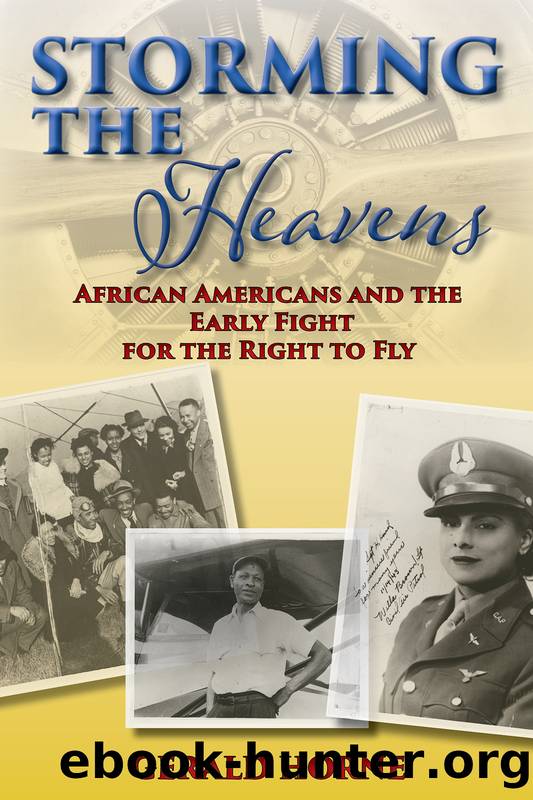Storming the Heavens by Horne Gerald;

Author:Horne, Gerald;
Language: eng
Format: epub
Publisher: Black Classic Press
Published: 2018-07-14T16:00:00+00:00
Colonel Benjamin O. Davis. Air base at Rametti, Italy.
(Courtesy Library of Congress, Prints and Photographs)
CHAPTER 6
MORE TURBULENCE
In early 1950, Claude Barnett and his spouse, the actor and singer Etta Moten, were visiting Haiti. At the time, the island was just 4.5 hours from Miami by air, with a stop in Cuba or Jamaica, and flights took off and landed daily at a round-trip cost of $110. While there, they encountered James Plinton, a former Tuskegee Airman who was notorious for flying his plane so low that he terrorized the earthbound. After the war, Plinton, a college graduate, tried to start an aircraft company in Liberia, but the venture collapsed when Pan Am and Firestone Rubberâthe latter being the giant of that nationâs economyâbalked at training African pilots. He then moved to Haiti and started an innovative dry-cleaning business. According to a dazzled Barnett, Plinton, with his staff of 20 Haitians, had âone of the most successful businesses imaginable.â âHe still flies an airplane which he use[s] to pick up and deliver garments to the various towns within a range of 25 miles,â reported the newsman.1
Barnett was surprised to find so many African Americans on the island, all âdoing worthwhile thingsâ as they reveled in the many âpossibilitiesâ offered there. Barnett claimed that the Haitian president told him that âhe was especially anxious to have American Negro business people come to Haiti.â In addition to Plinton, the Barnetts spotted other Negroes such as Giles Hubert, formerly of the faculty at Fisk University; James Johnston of Seattle, a forester trained at the University of Washington; Elle Griffin of Massachusetts, then with the United Nations Educational, Scientific, and Cultural Organization (UNESCO); and Griffinâs UNESCO colleague, Barrington Dunbar. Also present on the island were Edzier Carter, an artist from Chicago, and many more.2
As this episode involving Barnett suggests, aviation provided a unique form of upward mobility for African Americans. Piloting was a fungible skill that could be deployed in Africa as easily as in the Caribbean, and planes could easily transport those willing to depart the land of Jim Crow to places far away from its ordinary terror. Abroad, U.S. Negroes also could exert influence on independent nations, who could then pressure Washington in anti-colonial and anti-racist ways. Additionally suggestive of aviationâs increasing grip on the African American imagination was the name Chicago publisher John H. Johnsonâs gave to his wildly popular weekly magazine launched in 1951. Appropriately, the affluent Black businessman called the publication Jet.3
As the walls of Jim Crow began to crack and crumble, Plinton, who organized a successful airline venture in Ecuador after his sojourn in Haiti,4 eventually was hired by a U.S. airline.5 Tellingly, a few years after he left Liberia, that neo-colonial nation hired yet another African American aviatorâLeon Jordan of Kansas Cityâto supervise the training of its first pilots.6 Around the same time, Pan Amâs Juan Trippe, in a bow to commercial if not racial reality, resumed his active business interests in Liberia, initiating direct flights between New York and Monrovia.
Download
This site does not store any files on its server. We only index and link to content provided by other sites. Please contact the content providers to delete copyright contents if any and email us, we'll remove relevant links or contents immediately.
Harry Potter and the Goblet Of Fire by J.K. Rowling(3025)
Unfinished: A Memoir by Priyanka Chopra Jonas(2911)
Never by Ken Follett(2873)
The Man Who Died Twice by Richard Osman(2290)
Machine Learning at Scale with H2O by Gregory Keys | David Whiting(2267)
Fairy Tale by Stephen King(2058)
Will by Will Smith(2033)
Rationality by Steven Pinker(1761)
The Storyteller by Dave Grohl(1656)
The Dawn of Everything: A New History of Humanity by David Graeber & David Wengrow(1564)
The Dark Hours by Michael Connelly(1562)
The Stranger in the Lifeboat by Mitch Albom(1529)
Cloud Cuckoo Land by Anthony Doerr(1428)
Friends, Lovers, and the Big Terrible Thing by Matthew Perry(1324)
The Becoming by Nora Roberts(1323)
Einstein: His Life and Universe by Walter Isaacson(1312)
Crying in H Mart by Michelle Zauner(1312)
New Morning Mercies: A Daily Gospel Devotional by Paul David Tripp(1301)
A Short History of War by Jeremy Black(1295)
